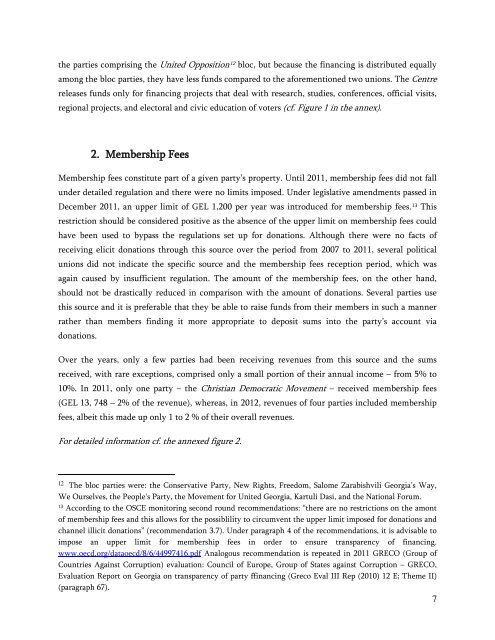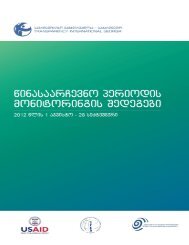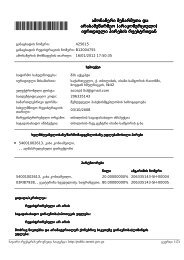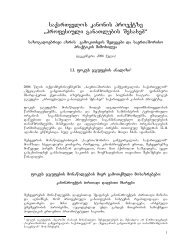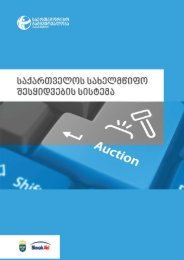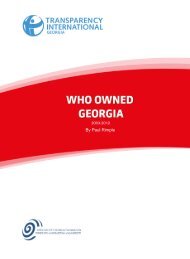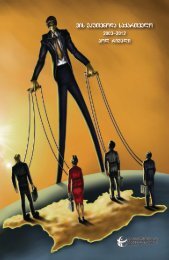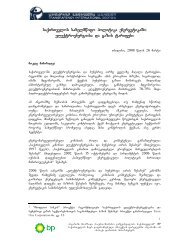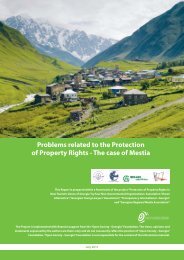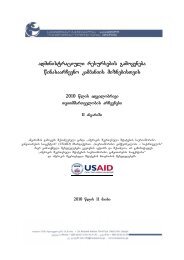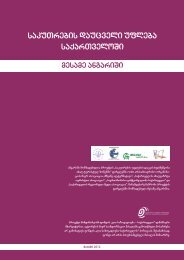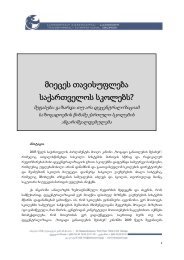PF ENG.pdf
PF ENG.pdf
PF ENG.pdf
- No tags were found...
You also want an ePaper? Increase the reach of your titles
YUMPU automatically turns print PDFs into web optimized ePapers that Google loves.
the parties comprising the United Opposition 12 bloc, but because the financing is distributed equallyamong the bloc parties, they have less funds compared to the aforementioned two unions. The Centrereleases funds only for financing projects that deal with research, studies, conferences, official visits,regional projects, and electoral and civic education of voters (cf. Figure 1 in the annex).2. Membership FeesMembership fees constitute part of a given party’s property. Until 2011, membership fees did not fallunder detailed regulation and there were no limits imposed. Under legislative amendments passed inDecember 2011, an upper limit of GEL 1,200 per year was introduced for membership fees. 13 Thisrestriction should be considered positive as the absence of the upper limit on membership fees couldhave been used to bypass the regulations set up for donations. Although there were no facts ofreceiving elicit donations through this source over the period from 2007 to 2011, several politicalunions did not indicate the specific source and the membership fees reception period, which wasagain caused by insufficient regulation. The amount of the membership fees, on the other hand,should not be drastically reduced in comparison with the amount of donations. Several parties usethis source and it is preferable that they be able to raise funds from their members in such a mannerrather than members finding it more appropriate to deposit sums into the party’s account viadonations.Over the years, only a few parties had been receiving revenues from this source and the sumsreceived, with rare exceptions, comprised only a small portion of their annual income – from 5% to10%. In 2011, only one party – the Christian Democratic Movement – received membership fees(GEL 13, 748 – 2% of the revenue), whereas, in 2012, revenues of four parties included membershipfees, albeit this made up only 1 to 2 % of their overall revenues.For detailed information cf. the annexed figure 2.12 The bloc parties were: the Conservative Party, New Rights, Freedom, Salome Zarabishvili Georgia’s Way,We Ourselves, the People's Party, the Movement for United Georgia, Kartuli Dasi, and the National Forum.13According to the OSCE monitoring second round recommendations: “there are no restrictions on the amontof membership fees and this allows for the possiblility to circumvent the upper limit imposed for donations andchannel illicit donations” (recommendation 3.7). Under paragraph 4 of the recommendations, it is advisable toimpose an upper limit for membership fees in order to ensure transparency of financing.www.oecd.org/dataoecd/8/6/44997416.<strong>pdf</strong> Analogous recommendation is repeated in 2011 GRECO (Group ofCountries Against Corruption) evaluation: Council of Europe, Group of States against Corruption – GRECO,Evaluation Report on Georgia on transparency of party ffinancing (Greco Eval III Rep (2010) 12 E; Theme II)(paragraph 67).7


